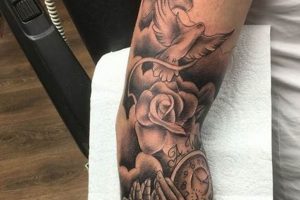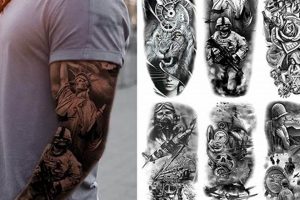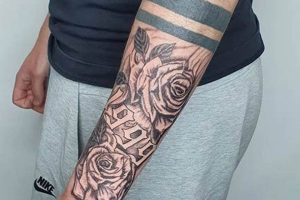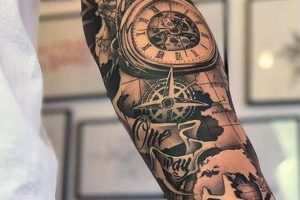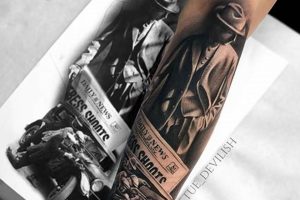Complementary designs intended to enhance larger, more prominent artwork in a full or half-sleeve tattoo composition are essential for visual cohesion. These supporting elements can range from simple geometric patterns and floral motifs to intricate shading and negative space techniques. For example, strategically placed dots, lines, or small symbols can connect disparate images, creating a unified and aesthetically pleasing flow across the arm or leg.
Cohesive visual transitions and thematic consistency are vital in large-scale tattoo projects like sleeves. Supplementing primary artwork with carefully chosen supporting visuals enhances the overall impact and tells a more complete story. Historically, many cultures utilized filler elements in their traditional body art, demonstrating an enduring understanding of their importance in achieving balance and aesthetic harmony. This practice continues in contemporary tattooing, ensuring visually appealing and meaningful compositions.
Exploration of specific motifs, design principles, and the collaborative process between artist and client will provide further understanding of how these supporting components contribute to successful sleeve tattoos.
Tips for Selecting Complementary Sleeve Tattoo Elements
Careful consideration of supplementary design elements is crucial for achieving a harmonious and visually appealing sleeve tattoo.
Tip 1: Maintain Thematic Consistency: Ensure all elements, including filler, align with the overall theme and narrative of the sleeve. A nature-themed sleeve, for instance, might incorporate leaves, vines, or water droplets as filler, while a geometric sleeve could utilize abstract shapes and lines.
Tip 2: Consider Scale and Placement: Smaller elements are ideal for filling gaps and creating transitions, whereas larger filler pieces can serve as focal points within the overall design. Strategic placement prevents overcrowding and ensures visual balance.
Tip 3: Explore Negative Space: Un-inked skin can be just as impactful as inked areas. Using negative space strategically can create contrast, highlight specific elements, and add depth to the design.
Tip 4: Utilize Shading and Texture: Subtle shading and texturing techniques add depth and dimension to the filler, preventing it from appearing flat or disconnected. These techniques can also blend different elements seamlessly.
Tip 5: Research Different Styles: Explore various artistic styles, such as dotwork, geometric patterns, or traditional Japanese motifs, to identify filler elements that complement the primary artwork and personal aesthetic.
Tip 6: Collaborate with a Skilled Artist: A professional tattoo artist can provide valuable insights and suggest appropriate filler elements based on the overall design, skin tone, and individual preferences. Open communication is essential for a successful outcome.
Tip 7: Plan for Future Additions: When planning a sleeve tattoo, consider potential future additions. Leaving strategic spaces or incorporating versatile filler elements allows for seamless integration of new artwork later.
Successful integration of these tips contributes to a cohesive and visually striking sleeve tattoo that tells a compelling story.
By understanding the importance of these elements and working closely with a skilled artist, individuals can achieve a truly unique and personalized piece of body art.
1. Backgrounds
Backgrounds serve as a foundational element in sleeve tattoo designs, providing a canvas that unifies disparate elements and enhances the overall composition. Strategic use of background filler creates visual depth, establishes thematic consistency, and contributes significantly to the flow and coherence of a full or half-sleeve tattoo.
- Solid Color/Gradient Backgrounds
A solid color or subtle gradient can create a cohesive backdrop for more intricate foreground elements. This technique provides contrast and allows focal points to stand out. Black or muted tones are frequently used for this approach, creating a dramatic and visually striking effect, particularly in conjunction with bolder, brighter artwork.
- Patterned Backgrounds
Repeating geometric patterns, such as mandalas, tessellations, or scales, can add texture and visual interest to a sleeve. These patterns can be subtle or bold, depending on the desired effect. Traditional Japanese tattooing often incorporates wave patterns or clouds as background fillers, contributing to the overall narrative and symbolism.
- Organic Backgrounds
Natural elements like smoke, clouds, fire, or water can create dynamic and flowing backgrounds, particularly for sleeves with nature-themed or abstract imagery. The swirling patterns inherent in these designs contribute a sense of movement and depth, unifying disparate elements across the skin’s surface.
- Textured Backgrounds
Techniques like stippling, dotwork, or brushstrokes can create textured backgrounds that add depth and dimension. These subtle background fillers can enhance the overall aesthetic without overpowering the main design elements. They can also simulate the appearance of fabric or other materials, adding complexity to the narrative.
Successfully integrating background fillers requires careful consideration of their interaction with the main tattoo elements. Balance, contrast, and thematic consistency are crucial for a cohesive and aesthetically pleasing sleeve tattoo. Careful selection of appropriate background filler contributes significantly to the visual impact and narrative coherence of the overall design.
2. Connecting Elements
Connecting elements play a crucial role in unifying disparate visual components within a sleeve tattoo, transforming individual designs into a cohesive and harmonious whole. These elements bridge the gaps between larger pieces, guiding the viewer’s eye across the skin and establishing a sense of flow and narrative continuity. Without effective connectors, a sleeve can appear fragmented and lack overall impact. For example, a sleeve featuring various animals might utilize flowing water or wind patterns as connecting elements, suggesting a shared environment and creating a visual narrative. Similarly, geometric patterns or abstract lines can link diverse imagery in a more abstract or stylized sleeve.
Strategic placement and thoughtful design of connecting elements are essential for their effectiveness. Overuse can lead to visual clutter, while insufficient connection can result in a disjointed appearance. The scale and complexity of connecting elements should be proportional to the surrounding artwork. Delicate floral vines might effectively connect smaller, detailed pieces, whereas bolder, more graphic elements might be necessary to bridge larger, more prominent designs. Consider a sleeve featuring portraits of loved ones: Intricate filigree or flowing script could connect the portraits, symbolizing relationships and shared history. Conversely, a sleeve depicting scenes from a favorite book might employ imagery related to the story’s setting or plot as connecting elements, furthering the narrative and enriching the overall design.
Successful implementation of connecting elements hinges on a clear understanding of their function and impact. These elements contribute significantly to the visual harmony and narrative coherence of a sleeve tattoo. Careful consideration of scale, style, and thematic relevance ensures these components enhance, rather than detract from, the overall composition. The choice of connecting elements should always serve the broader narrative of the sleeve, contributing to a unified and visually compelling piece of body art.
3. Shading/Texture
Shading and texturing techniques are essential components within sleeve tattoo filler, significantly impacting the overall depth, dimension, and visual interest of the design. These techniques move beyond simply filling space; they create the illusion of three-dimensionality, enhance contrast, and unify disparate elements. Consider a sleeve featuring various flowers: Skilled shading creates depth within each petal, making them appear lifelike, while subtle texturing might mimic the velvety feel of a rose or the rough texture of a sunflower’s stem. These details elevate the design, moving beyond a flat, two-dimensional representation.
The interplay of light and shadow achieved through shading techniques adds realism and visual drama. Subtle gradients can create the illusion of curves and contours, while darker shading adds weight and emphasis. Texture, often achieved through techniques like stippling, cross-hatching, or whip shading, provides tactile depth and visual richness. Imagine a sleeve incorporating metallic elements: Strategic shading and texturing can mimic the gleam of polished gold or the rough texture of weathered bronze, enhancing the realism and visual impact. Similarly, texturing can replicate the appearance of wood grain, fur, or fabric, expanding the range of possibilities within a sleeve’s narrative.
Effective use of shading and texture elevates filler elements beyond mere background details, transforming them into integral components of the overall composition. These techniques enhance visual cohesion, create a sense of depth and movement, and contribute significantly to the overall aesthetic impact. Understanding their importance enables more informed design choices and facilitates a deeper appreciation of the artistry involved in creating a successful and visually compelling sleeve tattoo.
4. Small Motifs
Small motifs serve as versatile and impactful filler elements within sleeve tattoo designs, offering opportunities for intricate detail, symbolic representation, and enhanced visual cohesion. Their smaller scale allows strategic placement within the larger composition, filling gaps, creating transitions, and adding layers of meaning without overwhelming the primary artwork. Consider a sleeve depicting a forest scene: Small motifs like acorns, mushrooms, or insects can populate the undergrowth, adding depth and complexity without detracting from larger elements like trees and animals. Similarly, in a geometric sleeve, small shapes like triangles, dots, or spirals can create intricate patterns and visual texture.
The symbolic potential of small motifs further enhances their value as filler elements. Stars, for example, can represent guidance or ambition, while feathers might symbolize freedom or spirituality. Incorporating culturally significant symbols or personal emblems adds layers of personal meaning to the sleeve. A sleeve focused on Japanese imagery might incorporate small cherry blossoms representing fleeting beauty, or koi fish symbolizing perseverance. These small details enrich the narrative and create a deeper connection between the wearer and their tattoo. Practical application involves careful consideration of motif size and placement to ensure balanced visual weight and prevent overcrowding. Excessive use of small motifs can create a cluttered appearance, diminishing their individual impact and the overall coherence of the sleeve.
Effective utilization of small motifs contributes significantly to the visual richness and narrative depth of a sleeve tattoo. Their ability to enhance visual interest, symbolize personal meaning, and seamlessly integrate within larger compositions makes them invaluable tools for achieving a cohesive and aesthetically compelling design. Understanding their impact empowers both artist and client to make informed decisions that contribute to a truly unique and meaningful piece of body art. Careful selection and strategic placement are crucial for maximizing the impact of these small but powerful design elements.
5. Negative Space
Negative space, the strategic use of un-inked skin within a tattoo design, represents a powerful tool in the context of sleeve filler. Rather than merely serving as background, negative space becomes an active design element, shaping the composition, enhancing contrast, and contributing to the overall visual impact. It provides visual breathing room, preventing the sleeve from appearing overcrowded and allowing the eye to focus on the intended focal points. Consider a sleeve featuring a flock of birds: Negative space can define the shapes of individual birds, creating a sense of movement and depth without the need for extensive outlining. Similarly, in a geometric sleeve, negative space can delineate intricate patterns and create the illusion of overlapping shapes, adding layers of complexity and visual interest. The interplay between inked and un-inked areas adds a dynamic element, contributing to a more sophisticated and visually engaging design.
Understanding the interplay between positive and negative elements is crucial for achieving balance and visual harmony within a sleeve composition. Negative space provides contrast, making the inked areas stand out more prominently. It can also be used to create subtle visual effects, such as the illusion of transparency or depth. Imagine a sleeve incorporating floral elements: Negative space can define the delicate petals of a flower, allowing light to seemingly pass through them, creating an ethereal and delicate effect. In a portrait, negative space can define facial features, adding depth and realism without relying solely on shading. This strategic use of un-inked skin requires careful planning and a skilled artist who understands its potential to enhance the overall design.
Masterful use of negative space elevates sleeve tattoo filler beyond mere background, transforming it into an integral part of the artistic expression. It adds depth, enhances contrast, and contributes to a more balanced and visually compelling composition. Recognizing the potential of negative space empowers both artist and client to explore more nuanced and sophisticated design choices, ultimately resulting in a more meaningful and aesthetically impactful piece of body art. The strategic incorporation of negative space requires careful consideration and skillful execution, but the resulting visual impact justifies the effort, contributing to a truly unique and impactful sleeve tattoo.
Frequently Asked Questions about Sleeve Tattoo Fillers
This section addresses common inquiries regarding the selection and implementation of filler elements in sleeve tattoo designs.
Question 1: How does one choose appropriate filler for a sleeve tattoo?
Filler selection depends on the overall theme, existing artwork, and personal preferences. Consider elements that complement the main designs and enhance visual cohesion. Consult with a skilled tattoo artist to explore options that align with individual aesthetic goals.
Question 2: Can filler be added to an existing sleeve tattoo?
Yes, skilled artists can seamlessly integrate filler into existing sleeves. Careful planning ensures cohesive integration with the current design. Discuss desired additions with the artist to determine feasibility and optimal placement.
Question 3: How much does sleeve filler typically cost?
Cost varies based on complexity, size, artist’s hourly rate, and studio location. Discuss budget constraints with the artist upfront to ensure alignment of expectations and financial planning.
Question 4: How long does it take to add filler to a sleeve?
Time required depends on the complexity and size of the filler elements. Simple geometric patterns may require minimal time, while intricate details can necessitate multiple sessions. Discuss timelines with the artist for accurate scheduling.
Question 5: What if one is unsure about specific filler designs?
Collaboration with a skilled tattoo artist is essential. Artists offer expertise, provide visual mock-ups, and suggest options based on individual preferences and the existing artwork. Open communication ensures a satisfying outcome.
Question 6: How does filler impact the overall healing process of a sleeve tattoo?
The addition of filler generally does not significantly alter the healing process. Adhere to the artist’s aftercare instructions for proper healing and optimal color retention. Consult with the artist regarding any specific concerns related to healing.
Careful planning and collaboration with a skilled artist are crucial for successful filler integration within a sleeve tattoo. Addressing these common questions facilitates informed decision-making and contributes to a positive tattooing experience.
Further exploration of specific design styles and individual consultations with experienced tattoo artists will provide personalized guidance and ensure a cohesive and aesthetically pleasing final result.
Conclusion
Successful sleeve tattoo composition relies heavily on the thoughtful integration of complementary artwork. Strategic implementation of background fillers, connecting elements, shading and texturing, small motifs, and negative space elevates individual tattoos into a cohesive narrative. These supporting elements enhance visual flow, add depth and dimension, and contribute to the overall aesthetic impact of the sleeve.
Consideration of thematic consistency, strategic placement, and collaboration with a skilled artist are crucial for achieving a harmonious and impactful design. Well-executed filler choices transform a collection of individual tattoos into a unified and visually compelling work of art, reflecting personal style and narrative intent. Thorough planning and open communication with a professional artist ensure a successful and meaningful result.



